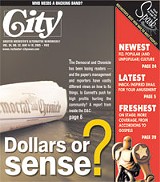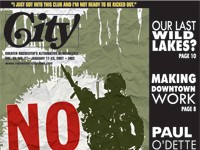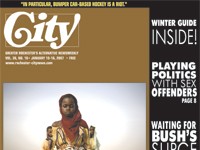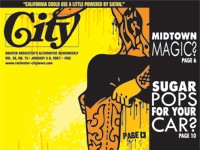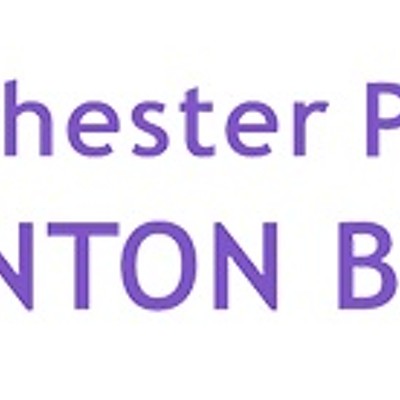[
{
"name": "500x250 Ad",
"insertPoint": "5",
"component": "15667920",
"parentWrapperClass": "",
"requiredCountToDisplay": "1"
}
]
"I go to work angry every day, and I go home angry every day."
That's how one Democrat and Chronicle reporter --- speaking on condition of anonymity --- described what it's like working inside Rochester's largest news outlet.
That might be an extreme description, but among rank and file newsroom staffers, confidence in the paper and its leadership is apparently in short supply and is dwindling. A poll conducted in February by the Newspaper Guild of Rochester, the newsroom union, indicates that growing number of newsroom employees think the paper's quality and the quality of news judgment are declining.
This takes place against the backdrop of the Guild's contract dispute with the Democrat and Chronicle. The Guild is entering its 13th year without a contract, and its leaders say this is the longest-running labor dispute in Rochester.
Major sticking points are benefits like health insurance and pensions and what the Guild says are some of the lowest contractual minimum salaries among unionized newsrooms. An especially sore point: The D&C excludes Guild members from the 401(k) plan it offers to its other employees.
"It's a daily, continual insult," says one reporter.
But this story isn't just about a labor dispute or some workers unhappy with their boss. It's about the state of newspapers in this nation and the future of journalism in this town.
The bursting of the media bubble
When the Guild launched its latest campaign earlier this year, it ran ads in publications like City Newspaper and on billboards around Rochester.
The ads did more than cite complaints about pay and benefits. They charged that D&C management has cut its newsroom staff, and that those cuts are not just bad for journalists, they're "unfair to readers."
The slow shrinking of the newsroom, the Guild says, has occurred despite Gannett's healthy profits. And that, says the Guild's website, is a "symptom" of the company's "willingness to shortchange its customers, to meet the profit goal."
Says one reporter: "You would think that a business that depends on experience -- general and beat experience -- and on institutional memory would value its employees more. What is a newspaper without good reporters and line editors?"
A 13-year labor dispute may be unique to the D&C, but combined financial and journalistic pressures are not. Look at Romenesko, Editor and Publisher, and other online sites devoted to the news about the news, and you'll be privy to an ongoing discussion about the future of the daily newspaper in the United States. Most dailies have been losing circulation for several years, making them less attractive to advertisers. The loss is especially acute in the younger demographics that advertisers crave.
Earlier this week, the Audit Bureau of Circulationsreported the latest bad news: Dailies throughout the country lost circulation in the past year. There were a few exceptions --- the New York Times, for example, grew by about 3500 --- but on average, the circulation of dailies dropped by about 2 percent on weekdays, and more than that on Sundays.
The Democrat and Chronicle has been part of that trend. Since 2002, its average weekday circulation has declined by 2.5 percent, according to statistics released Monday by the Audit Bureau of Circulations. (The figures are based on the D&C's own reports. ABC's audited reports will be released later.)
And the drop would have been larger if the D&C hadn't done what many dailies have been doing: boosting what are known as "third-party sales." Dailies often sell bulk copies to hotels and restaurants to provide to customers, and to school districts for classroom use.
Between 2002 and 2005, the D&C increased the number of its third-party-sale copies by 5757, according to the ABC report.
Add to that loss the sustained explosion of new media outlets competing for readers' and advertisers' attention --- cable, internet news sites, blogs --- and daily newspapers are fighting for, if not their lives, at least their existence in their present form.
It's not a fight everyone expects the dailies to win. The New York Observer's Richard Brookhiser predicts that new incarnations of the Wall Street Journal, the New York Times, and the Washington Post "will be interesting and useful, but they won't be what they were."
"Other newspapers will dwindle to sheets of shopping coupons," writes Brookhiser, "with notices of weddings and school-board meetings." Brookhiser is among the most pessimistic of the media critics, but editors aren't having a good laugh at his expense just yet, either.
An industry-wide business downturn is just part of the picture. To consider the Guild's claim, we need to look at two more pieces of the puzzle. Here's the first: Journalism is more than just a way to connect advertisers with readers and make a buck in the process. It's also "a vital public service in a democracy where citizens rely on information to vote and to form and freely express opinions," as veteran media critic Ken Auletta puts it in the introduction to his book Backstory.
Like all companies, newspapers have to make tough business decisions. But newspapers' status as a public trust gives those decisions far-reaching implications. When Kodak contracted from 60,000 to about 16,000 employees locally, Rochester suffered as a community from the economic ripple effects of money going into the pockets of fewer local workers. But we didn't suffer as a community from a shortage of cameras or a spike in their cost.
On the other hand, if the D&C makes decisions --- on the basis of business needs --- that affect its employees' ability to gather and disseminate the news, we all lose. The Guild says that's what has begun to happen at the daily.
Another factor worth scrutiny: the D&C's relationship to its corporate parent.
Though the paper's top managers says they enjoy a high degree of autonomy, the D&C is part of Gannett Company, Inc., which owns more than 100 daily newspapers in the United States and the United Kingdom, including USA Today. Gannett also owns 21 television stations, specialty publications such as Army Times and Nursing Spectrum, and Clipper, a direct-mail coupon publication. As the D&C's president and publisher David Hunke puts it: "We're an operating unit of a large multi-national corporation."
Since Gannett is a publicly traded corporation, its first obligation is to its shareholders. For its stock to remain attractive to investors, Gannett needs to keep growing its profits and the business as a whole.
So while all newspapers are being squeezed between the poles of profit and public service, newspapers owned by publicly held companies like Gannett are being squeezed the hardest. The Guild quotes a Merrill Lynch report putting Gannett Company Inc.'s profit at 25 percent. Hunke won't say exactly what the D&C earns, but, he says, Gannett doesn't set profit quotas for its individual newspapers.
"It's a process of us agreeing first of all on our top-line revenues projections, our advertising and circulation strategies, and then the cost structure we're going to need to deliver that," he says.
A Guild member insists that Gannett does dictate the profit expectations. "What they do," says that reporter, "is they'll set a profit target for each unit, each newspaper, each TV station, and then, by god, if you don't meet it the shit hits the fan."
The profit target "may have come down a few pegs because of the local economy," says the Guild member, "but it's high; it's scandalously high."
Several years ago, a reporter at Nashville's alternative newsweekly, the Nashville Scene, got hold of internal Gannett documents showing each title's pretax profit margin. The Democrat and Chronicle clocked in at 34.4 percent for 1996 and 34.6 for 1997. (That put the D&C well into the "above average" category, though it was by no means Gannett's most profitable paper. Papers in Binghamton and Utica scored much higher in 1997, at 44.8 percent and 43.6 percent, respectively.)
Although the numbers may have decreased a bit since then, the line in 1996-1997 between above-average and below average was within a percentage point or two of Gannett's profit level today.
Such profit levels are well above what Washington Post Editor Leonard Downie Jr. says newspapers need to make. Addressing a meeting of the Association of Newspaper Editors in early April, Downie said a 15 percent return ought to be sufficient, Editor and Publisher magazine reported. "That is much better than supermarkets or some other businesses," Downie said. "Most of the public is shocked when you tell them what the average profit margin is."
The E&P article went on to describe Downie's criticism of owners whose papers were shrinking because they had cut resources "to maximize profit in the stock market." He didn't single out Gannett or any other chain as an example, but he did cite privately-held companies as those who still consistently perform good journalism.
'More like a weekly'
Journalists, writes Ken Auletta, need to understand how important it is to make a profit in the news business: That's not only what pays the bills, but it's what funds more staff, more experienced staff, expensive investigations, and bureaus in outlying areas or in state capitals and Washington. But journalists also need to be able to argue against high profit margins, Auletta says.
"They need to show how a 20 percent profit margin (versus, say, 15 percent) may mean cutting bone, not fat," he writes. "Shareholders want a 20 percent profit margin --- but not if in the long run it means they own a diminished asset."
That's the argument the reporters, photographers, and copy editors at the Democrat and Chronicle are trying to make. The picture painted by sources in the D&C newsroom is of a paper that has largely abandoned its drive to be a comprehensive metropolitan daily in the years since the afternoon daily the Times-Union was shuttered, and its staff was folded into the D&C. (None of those sources, all non-management employees from the paper's editorial side, would speak on the record.)
"I was convinced this was a big-city newspaper," says one reporter. "We considered ourselves a metro paper. Today, we read more like a weekly, and that's the direction that editor Karen Magnuson is taking the paper."
The staffers also complain about the small size of the staff and the lack of time and resources to develop stories and go after context and depth.
"Staffing is laughable," says another reporter. "There are two people working nightside in the newsroom --- a police reporter and an editor." That's down from two reporters, two editors, and two editorial clerks who regularly worked the evening shift a few years ago, the reporter says.
Steve Orr, who spoke to City only in his capacity as union president, agrees with that description.
"The biggest problem is just people," he says. "There just aren't enough people." Through attrition, the company has slowly but steadily diminished the number of reporters, Orr says.
"They only fill a small fraction of the jobs that come vacant through people leaving or retiring," he says. "We're at the point now where we are clearly short-staffed. Management indicates this openly in meetings, that we're hurting, and it's plainly evident to all of us that work there."
Another beef: travel. The Guild's new website, www.rochesterguild.org, says that newsroom staffers no longer bother asking to travel outside the immediate Rochester area to cover news "because they know they're not likely to get it."
"Travel expenses are unheard of," says one reporter, "unless you report on football."
Former D&C reporter Jay Tokasz recently returned from Rome, where he covered the funeral of Pope John Paul II and the election and installation of Pope Benedict XVI for The Buffalo News. That irked the Rochester newsroom staffers, who watched their own paper rely on wire-service feeds for the event.
"We no longer think big, and that bothers me a great deal," one reporter says. "I think we shortchange readers by not providing enough context and perspective. You've got to get out of your world to understand it."
The Guild has tried to document its charge that the quality of the D&C's news coverage has deteriorated --- to the extent that it's possible. The staff that the Guild represents is down about 40 percent, Guild officers say, from about 160 in 1992 when the staffs of the D&C and the T-U were merged, to just about 100 today. The Guild has also documented a decline in the paper's beats and news bureaus.
Consider this from Guild officials:
"Here is a partial listing of full-time beats that no longer are filled: agriculture; editorial cartoonist; three editorial writer slots; at least seven general-assignment reporting slots; theater; social trends, and women's issues; Rochester society; television and media; at least four editorial-assistant slots; minority affairs; transportation; nine graphic-artist slots; social services; at least two photographer slots; city living-urban affairs; demographics; one high-school and one college sports reporting slot; personal fitness; federal courts, and at least three metro columnist slots. We also have lost two or three suburban reporting slots, and four or five reporting slots in Our Towns, the zoned weekly section."
The Guild also points to the closure of bureaus in Batavia, Geneva, Victor, and Livingston and WayneCounties.
"If you go back 20 years or so, we also had bureaus in Penn Yan, YatesCounty; Seneca Falls, SenecaCounty; Bath, SteubenCounty, and in OrleansCounty," say Guild officials. "At present, we have only one reporter stationed outside of Rochester, in Canandaigua."
That doesn't mean that the D&C never covers those areas, the Guild acknowledges; reporters are assigned to keep tabs on happenings in outlying towns and counties.
"But they do so on a very limited basis," the Guild contends. "Instead of knowing their subject well, they do their best to keep up with major developments, but that might be all they have time to do. We have reporters who 'cover' each of those outlying counties. But they each also cover several Monroe County towns, too, and have no time to keep abreast of anything but the biggest and most obvious stories in the outlying counties."
Some of the Guild's concerns are impossible to document in numbers. One is the size of the "newshole," an industry term for the amount of space set aside for news. You might think that'd be a simple matter of counting inches, but since the paper keeps repackaging itself, the newshole is a moving target.
"We cannot document the shrinking newshole in any numerical way," say Guild officials. "We've tried, and it's devilishly hard to do well. Obviously, if you go back a decade or so where there were two daily papers here, the newshole is radically smaller. But to compare today's D&C to one from five years ago, that's harder, because new elements appear and old ones disappear. The paper just added space, for instance, to the Sunday features section. Did it come from elsewhere in the newspaper? There's no easy way for us to tell."
"Our perception is that newshole devoted to local news, business, and national and international news is less, though," says the Guild. "That is counterbalanced, of course, by the appearance of occasional 'extra sections' such as health or business-related tabs or last year's Fighting for Rochester's Future sections."
Filling the newshole
Whether the newshole has shrunk also depends on your definition of the newshole, which depends in turn upon your perspective.
By Democrat and Chronicle Publisher David Hunke's reckoning, the newshole hasn't shrunk at all. "The number of gross news columns that we publish at this newspaper isn't significantly less than it was when we merged the two newspapers," he says.
Hunke admits that he has cut things like two stock pages. ("That was a business-driven decision, and one you don't like to make," he says.) And he doesn't deny trimming in other areas as well.
Part of that reflects shifts in the way people get information. The online versions of journalistic powerhouses like The New York Times or BBC provide faster --- and sometimes deeper --- reports of breaking national and international events than readers can get from a wire-service article in the next day's paper.
"That information is available almost in any form you want," says Hunke, "and I don't know that people turn to newspapers for that first and foremost."
But he dismisses the notion that the paper is shrinking.
"I don't blame people for being unhappy when they see those things," Hunke says. "The problem I have with the Guild's ad campaign statement is it doesn't take into account a lot of reinvestment we've made in newshole in special sections, special projects, which we do many more today than we've done in the past. We've doubled the arts coverage --- beginning in January --- of our Living section, and that almost brings [the newshole] back to where it was before we cut the stock pages. But it does come back in clusters and in projects, as opposed to just laid out seven days a week the way I think it might have been seen in the past."
This propensity to continually repackage the paper has its roots in a deep-seated fear: that readers don't care about the news anymore. The number of Americans reading a daily newspaper has dropped from more than 80 percent in the mid 1960s to just over 50 percent today. And those readers are an aging bunch.
Even worse, a growing body of studies suggests that not only are younger generations not reading newspapers, they aren't getting news from the internet or anywhere else, either. They're ignoring it. Columbia Journalism Review Publisher Evan Cornog, in an article on the subject of reader apathy titled "Let's Blame the Readers," cited this statistic from a UCLA survey: While 60 percent of college freshmen in 1966 believed it was important to keep up with political news, by 2003 only 34 percent did.
"Younger Americans know plenty about the things that interest them --- they just don't follow the news very closely," wrote Cornog. "Given the close correlation researchers have found between newspaper reading and active citizenship, the figures are worrisome for both the industry and the nation."
That's a concern Hunke shares.
"I'm worried about people's disengagement and lack of interest, and people who think they don't really need to know or hear things," he says.
The future of the newspaper, says Hunke, is not a technology issue.
"I think it's a sociology issue," he says. "When people quit defining their community as Rochester or Brighton or Hilton, and they define their community through some other technological means that can take them into groups, clusters --- or their world is delivered to them [through] fiber optics or satellite or something else, and they don't know the pharmacist at the end of the sidewalk at the little store, and they don't go to PTA meetings --- that's the threat to newspapers."
The Democrat and Chronicle under the leadership of Hunke and Magnuson has reacted to this problem in two different ways.
First, it has pushed the idea of repackaging the paper to the next logical step: With separate publications like Insider, The Big Auto Book, and the forthcoming Rochester Magazine (an upscale lifestyle mag due out in June), the paper's trying to make an end run around waning interest in news by providing niche content to target audiences. Those target audiences also happen to be target markets, and the D&C's move is calculated to offset circulation losses at the daily by offering advertisers more options.
The push to fragment Rochester into a series of niche markets isn't unique to the D&C or even the Gannett chain. Like spurned lovers, newspapers everywhere are trying just about anything they or their marketing consultants can think of to get readers back. It's arguable whether replacing "hard news" with the niche content that dominates these spin-offs is a good trade-off for the communities these newspapers serve. But don't expect it to stop anytime soon.
"We're going to rapidly expand our product lines," says Hunke. "I look forward to a couple more projects that are in the pipeline and about to come out."
A second step the D&C has taken to stem the loss of readers is to try to figure out what those readers want and give it to them.
"We are creating sections that are serving the needs of readers based on talking with readers and also on scientific readership research," says Magnuson.
Armed with focus groups, "scientific readership studies," layers of readership panels, and plain old informal interaction with readers, the D&C is doing its best to be all things to all readers.
"We feel it's really important to be talking to readers all the time about what is important to them," says Magnuson, "so we have several reader panels that are set up throughout the newsroom. Every department has at least one, where they meet with readers on a pretty regular basis, sometimes once a month, sometimes every other month, to talk about the readers' perceptions about what's going on out in the community."
"That way," she says, "we can make sure that we are covering stories that are most meaningful to the readers we serve, as well as the regular stories that we would be covering anyway."
To fully appreciate how important pleasing readers is in Magnuson's newsroom, consider that fully three of the five changes she says she's proudest of during her tenure revolve around catering to reader response. (The other two are the paper's online reporting and its role as a watchdog for the community.)
First: "I'm most proud of what we've been able to do to connect with readers, because I think that in the days of old, newspaper editors didn't pay as much attention to that. They made all of their decisions based on their gut instinct, and today I think editors are better listeners. And the editors in my newsroom have become very good listeners when it comes to the readers in Rochester."
Then: "I'm also very pleased with this newsroom's ability to be nimble and change to meet the evolving needs of readers."
And finally: "I am very proud of how this newsroom has changed its thinking to make sure that journalism is more relevant to readers' daily lives. We can produce all of the journalism in the world, but if it's not relevant enough for readers to read it and be engaged, then it really doesn't achieve its goal."
But not all of the newsroom is on the same page as Magnuson when it comes to the value and use of reader input. One newsroom staffer offered this analogy to describe the way the paper operates: "Imagine a football game where all the plays are called by the people in the stands, one by one."
Being responsive to readers is an admirable trait, and a time-honored tradition in newspapering. But turning the reins over to a focus group to set the newsroom agenda might compromise some of Magnuson's other goals, like being a government watchdog on behalf of the community.
Low staffing levels also pose a potential problem for the paper's ability to fulfill what Magnuson describes as its watchdog responsibility. Magnuson points with pride to Steve Orr's reporting on the problems with CSX and its railway crossings after the death of a Rochester-area couple.
"What you do is hire really talented people who know a good story when they see it and then ask their editor for time to drill down and cover the hell out of it," she says. "There's not a reporter in our newsroom that couldn't come to their editor or me or the managing editor, Jane Sutter, and say: 'I've got a great story here; here's how much time I need to go after it, and this is how I'm going to do it. Can I go for it?' And we're going to say, Yes."
Both Magnuson and Hunke say they are every bit as concerned with the public-service element of journalism as the profits. And they point to the paper's "Fighting for Rochester's Future" project, an extensive study of the challenges facing Rochester.
"That's a perfect example; that had nothing to do with money," says Hunke. "That cost us money to do that." The payoff, they both say, is in the dialogue it sparked within the community.
And Magnuson says the paper is working with the Investigative Reporters and Editors organization to train the D&C staff "so that even our less experienced reporters have the skills to dig deeper."
But unless it increases its staff, for consistent investigative efforts the paper will have to rely on reporters who say they are already overworked covering their day-to-day, breaking-news responsibilities.
A mile wide, an inch deep?
Frank Gannett first got into the newspaper business here in our neck of the woods. He bought an interest in an Elmira paper in 1906 (its descendent the Star-Gazette is still owned by the chain). In 1918 he entered the Rochester market with the Times-Union, and in 1923 incorporated the company that would bear his name. The company showed up on Wall Street by the end of the 1960s, but its corporate headquarters stayed in Rochester until 1986.
Perhaps because of Gannett's roots in Rochester, the Guild's concern about putting profits before service to the community rings doubly true for many Rochesterians.
Says Guild President Steve Orr: "We like the paper, but the problem we have, and I think the problem that a lot of people in the community have, is that it is not all that it can be --- that it's not as big, to put it bluntly, as it used to be or as it should be in terms of the amount of news that it has room to publish, the amount of information it can convey, the diversity of opinion that it has the ability to communicate. We think it can be better."
The problem, says Orr, is that the paper's ability to "be better" is limited "by the approach that the Gannett company takes in Rochester." That approach: "To maximize the amount of money that it makes here to no particular local benefit, but --- as happens with many companies and industries all over the country --- to feed the beast, to go back into the corporate coffers."
Those coffers "23 or 24 years ago were on the upper floor of the LincolnTower," Orr reminds us. "And I think we've become not the flagship paper of the company anymore but just another cash cow, and a pretty substantial cash cow."
At the same time that Frank Gannett was assembling his empire, another type of nation-wide business empire was crumbling. Today that empire has become a handy metaphor for print journalism. In a recent article on the website of the Association of Alternative Newsweeklies, Jed Morey, publisher of the alternative weekly Long Island Press discussed his own paper's effort to redefine what it does:
"We had a very honest discussion last year and said, 'Let's make sure we don't wind up like the railroads at the turn of the century, thinking that we're in the railroad business and not the transportation business.'"
Newspapers are now faced with the tough problem of defining the essence of their business. That's a discussion the Guild and the newsroom rank and file it represents want to be a part of. If they were, there's little doubt they'd push to redefine the paper in the direction of their counterparts in larger cities --- as a comprehensive, news-heavy daily.
One reporter, taking aim at the readership-response method, has this prescription for the paper: "I would get back to the core business, which is reporting the news. Now the core business is responding to reader groups."
How Gannett and its local management define the core business of the Democrat and Chronicle may be a bit murkier. Responding to readers may be one definition. Magnuson's discussion about the importance of satisfying readers could have come directly from corporate literature describing Gannett's "Real Life, Real News" initiative. Among other objectives, the initiative seeks to further incorporate reader satisfaction into the way papers like the D&C measure their own success. Here's the way one corporate exec summed it up: "We must deliver what readers want, where they want it, when they want it, and how they want it."
Other initiatives designed to broaden the paper's appeal may not come from corporate headquarters in Virginia, but they have the same effect. They divert time and energy from newsgathering, and they can make the paper's content shallower in the process. One example is the D&C's strict guidelines calling for more mugshots and more quotes from minorities, women, and young people.
One reporter relates this experience: After completing an article, "I was told at the last minute that I had to have a minority quoted in the story, and I had to have a minority's photo appear with the story. I was told to just go out on the street and ask an African American what they thought and take a picture. Then, 'just squeeze it into the story.' What message does that send to reporters?"
"Overall, these are positive changes," the reporter says, "but we've gone off the deep end."
On the Gannett website, the company bills itself as "The Information Company." But what does that mean? A page on the website hyping "young reader publications" (of which the D&C's Insider is one), says that twenty- and thirty-somethings "view advertising as content." If that's the case, perhaps Gannett's core business (and that of the D&C, by extension) is providing an advertising vehicle.
That possibility crossed the minds of local journalists after the company selected current CEO Doug McCorkindale, "the first CEO Gannett's ever had who has never been a journalist," says Orr. "To us, it was kind of a symbolic letdown that probably says something about the directions of the company.
Mining for profits
"The thing that we're trying to do in this campaign, which I think is both honest and helpful, is to draw parallels between our labor dispute and the larger state of the newspaper and of journalism in Rochester," says Orr. "We don't think it's a bad newspaper. We like the newspaper. And we choose to work here. The people in the union work really hard, I mean, harder than ever in a lot of ways, probably, to do as good a job as we can. And there are a lot of things about the D&C that I like."
Orr isn't alone. Other D&C journalists with whom City spoke said substantially the same thing: "We care about the paper and want to see it get better," sums up one reporter. The Guild is convinced that Gannett is trying to break the union. And by doing that, the Guild says, the company and local management seem to be ignoring, or worse, stifling good ideas that could come from the people who report the news day in and day out.
"Human capital just means nothing in a business where you think it would mean everything," one reporter says. For Guild members, the 12 years without a contract seem like just another calculated business decision on the part of a company they see as increasingly valuing profit more than quality.
"I think it's inescapable that any newspaper that is mined as extensively as ours is for profits and managed with an eye toward profits is not going to offer its home community what the community deserves," says Orr. "And it's frustrating to us, because we want the newspaper to be able to do more. And we can't do more. We do new things, but every new thing we do means doing less of a job on something else that we were doing before."
"It makes the newspaper less than Rochester deserves," Orr says. "There's this incessant debate now about newspapers and where they're going. And the way I look at it is that for all of the warts and all of the criticism --- so much of which is valid --- that people direct toward the Democrat and Chronicle or toward any newspaper, it still is an essential part of the fabric of this community."
Want to comment?
Write
Next week: Columnist Laurence Britt on the news in the D&C.
Speaking of...
Latest in Featured story
More by Krestia DeGeorge
-

The last wild Finger Lakes
Jan 17, 2007 -

Designers get their turn at downtown
Jan 17, 2007 -

From the new governor: fighting words
Jan 10, 2007 - More »
